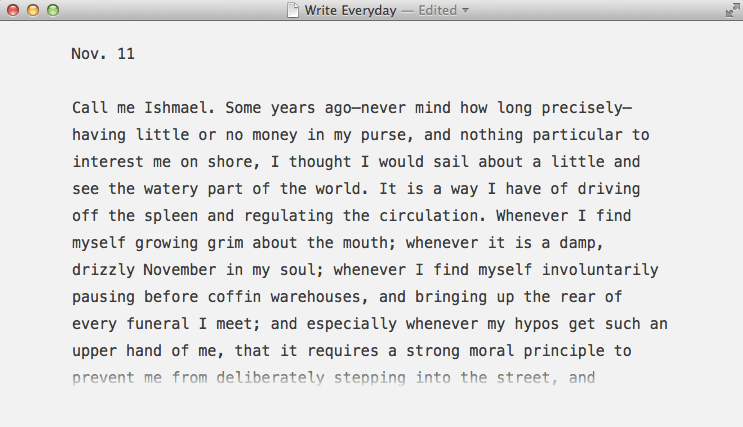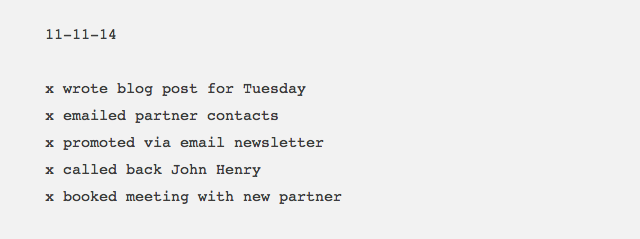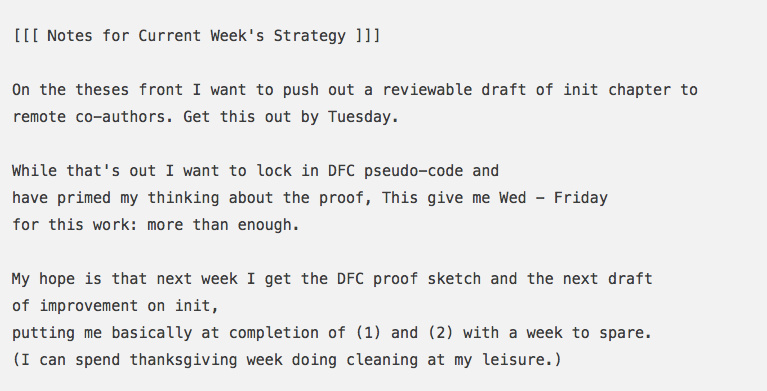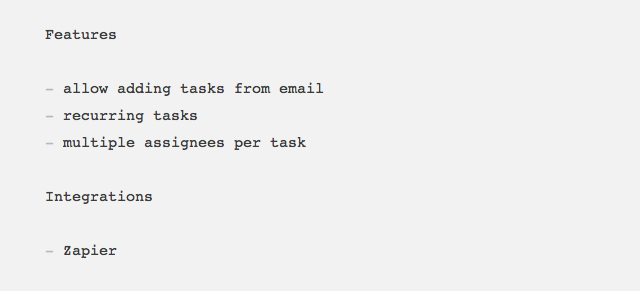When it comes to keeping track of all your text and to-do lists, there’s no shortage of apps to choose from, but sometimes the ease and simplicity of working with plain text files can actually be more productive. Here are ten clever plain text files that you might want to keep on hand.
This post originally appeared on the Zapier blog
If you’ve read an earlier post on the Zapier blog about staying productive without using to-do apps, you will have already seen a glimpse of the productive potential of plain text files. Keeping things simple can be quicker than loading a bloated app, in some cases. I came across some other clever uses of plain text files recently, so I wanted to pull them all together so you can pick and choose which ones will be most useful to you. Here are ten plain text files that you might want to keep on your desktop.
A “Write Every Day” File

I came across a comment somewhere in my wanderings around the internet that suggested this clever use of plain text files. The commenter had a single text file saved to their desktop in which they wrote something every day. The idea was to cultivate a daily writing habit, which many people do — often using separate text files per day, a journalling app, or a purpose-made app like 750 Words.
Using a single text file instead means all of your writing is together in one place, and it’s not stored online — it’s private and local. Plus, it’s easy to get started with: just open up the file each morning, type out the date and get writing. Later you can go back over your file to see what you wrote and how much you wrote per day. What really makes this a good use is the ease of entry — there’s no reason not to write when the text file is just a click away.
Manage Your To-Do List In Plain Text

Todo.txt’s syntax rules include setting priorities (A, B, C), contexts (@phone, @car, @store), and projects (+Work, +GarageSale).
Plain text to-do lists are one of the most useful and simplest ways of managing what you need to get done. Of course, you could create a plain text to do list any way you like, but if you want some extra bells and whistles, try
Todo.txt
by Gina Trapani, founder of Lifehacker and co-founder of ThinkUp. You can use Todo.txt’s syntax in the Android and iOS apps, from the command line, or in any text editor. For some text editors, you can get plugins to add things like syntax highlighting.
Keep Track Of What You’ve Accomplished With A “Done” List

There’s something to be said for seeing how much you’ve gotten done at the end of the day. You know how satisfying it is to cross out items on your to do list, and then look back at the list to see everything you completed? A “done” list, or “anti-to-do list” as Marc Andreessen calls it, works in a similar fashion: you simply take note of each thing you get done during the day.
Start out with the date and just list your “done” items underneath. Not only will this help you review your productivity at the end of each day and make you feel better about what you got done, but it can be really useful to keep around as a work log. You might want to look back in weeks or months to come to see what you were working on or how long a project took to complete.
Create An Action Plan For The Week

Computer scientist Cal Newport uses a text file to plan his week (example above) so he can get more done. Even if you use a complicated task management app, you might still benefit from doing a simple weekly plan like this. I do both, as I need a robust system to keep track of everything, but a simple to do list for the week keeps me from getting overwhelmed.
Cal doesn’t have any rules for his plan:
Once a week, usually on Mondays, I open a small text file named plan.txt and jot down my action plan for the week.
There are no hard rules for this plan. Some weeks it’s a few sentences. Usually, it’s a few paragraphs. Sometimes it spans multiple pages.
The great thing about using a text file for your weekly plan is that you have the flexibility to experiment. You don’t need to fit in with any particular feature set — just try out different ways of planning your week and stick with what works.
Keep A Plain Text Journal
There are some great apps for journalling, but if you don’t want to pay for yet another app just to hold your journal, a text file can work just as well. You won’t get the extra features of an app made for journalling, such as automatic weather data, tags, or adding images, but if your aim is to build the simple habit of penning some thoughts every day, plain text will more than suit your needs.
A related idea is writing letters for your children to read when they grow up. I came across this idea on Hacker News, where a parent mentioned writing emails to their son every day. If you’d rather store all that data yourself and not have it filling up an email account, you could use a text file to keep a running list of short letters to your children about their progress.
Collect Your Ideas In A Brainstorming File

I recently wrote about how to come up with better ideas. If you’re thinking up new ideas all the time, you’re going to want somewhere to put them. A simple text file can be a flexible way of storing your ideas — you can add a date if you want to, and you can come back to the list and add notes later to expand on it.
Track Your Own Data In A Self-Tracking File
With all the technology available now to help us track pretty much every aspect of our lives, you might wonder why anyone would opt for a text file instead. The answer is the same as it would be for any of the other ideas listed here — text files are flexible, simple, and future-proof. If you note down your exercise, measurements, habit progress, or other metrics in a text file, you won’t need to worry about whether your favourite service will keep your data safe, or how they want to structure it.
Of course, you also give up the option of connecting your data to other services via integrations and APIs, but if that’s not important for you, plain text will work.
Organise Your Feature Requests

This use is a little more niche, but if you work in product development, keeping your feature requests organised can be its own task. When you’re in the early stages of building a new product, a really simple way to keep track of feature requests is to just make a list in a plain text file. Save it to your desktop, and each time a user mentions a feature they want, add it to the list.
To keep track of which features are more popular, add a number beside each feature and increment it as you get more requests. It’s so simple, quick, and easy, and in the early stages of building something new, that’s often all you need.
Collect Tasks As Folders On Desktop

If you want to keep your to-do list simple by using plain text, but you want a little more organisation than keeping dozens of files spread across your desktop, you can use different folders to separate your tasks. Maybe you have different work projects that need different task lists, or you want to separate your tasks into contexts like work and home.
Another option is to use one folder per task. If you have a short list but you want to be able to see each and every task with just a glance at your desktop, create a new folder each time you add a task to your list. Developer Zac Holman of GitHub uses a simple script to do this from his command line, but you could just as easily do it manually. In fact, creating a folder manually for each task might even help you prioritise your task list, by making you rethink whether it deserves a spot on your desktop in the first place.
Decide On One Thing To Do Today
If you really need help getting more done, you might need to go for this extreme productivity method: create a very simple text file to save on your desktop that includes just one task to get done today.
The idea comes from John Henry Müller, who created this daily text file:

Müller keeps this file on his desktop so he’s always being reminded of what he should be working on.
There are some great tools available to make working with text easy, whether you want a fully-featured text editor or something designed for a specific kind of writing. Of course, you can use any old text editor for the tips we discussed and keep it simple — that’s the beauty of plain text.
10 Plain Text Files You Should Have on Your Desktop for Higher Productivity [Zapier]
Belle is a co-founder of Exist, a personal analytics platform to help you track and understand your life. She is a writer at Crew and was previously Buffer’s first Content Crafter and Head of Content at Attendly.
Image adapted from Max Griboedov (Shutterstock).

Comments
5 responses to “Ten Clever Uses For Plain Text Files That Can Increase Your Productivity”
My favourite plain text feature is is to use Notepad to create a log file. Some other text editors may have this feature too.
Open Notepad with a blank file and type .LOG on the first line, then save the file as somename.log.
Then each time you open the .log file notepad automatically adds the time and date to the bottom of the file.
Wow. That’s obscure.
Notepad also inserts the date if you press F5. I’ve done that many times, though never intentionally. 😉
You sir, have helped me immensely.
I have a Unicode file. When I find a fancy character, I add it to the file, along with its shortcut code. Greek (for math), Thai, arrows, box edges, musical notes. Starting on Korean and Chinese symbols.
I have taken to adding a font name as well, since not all fonts support some symbols. I can look up the code, or simply copy & paste.
I love the sticky notes you have up on screen.
they stay there unlike the paper ones which keep falling off haha
I might need a new system